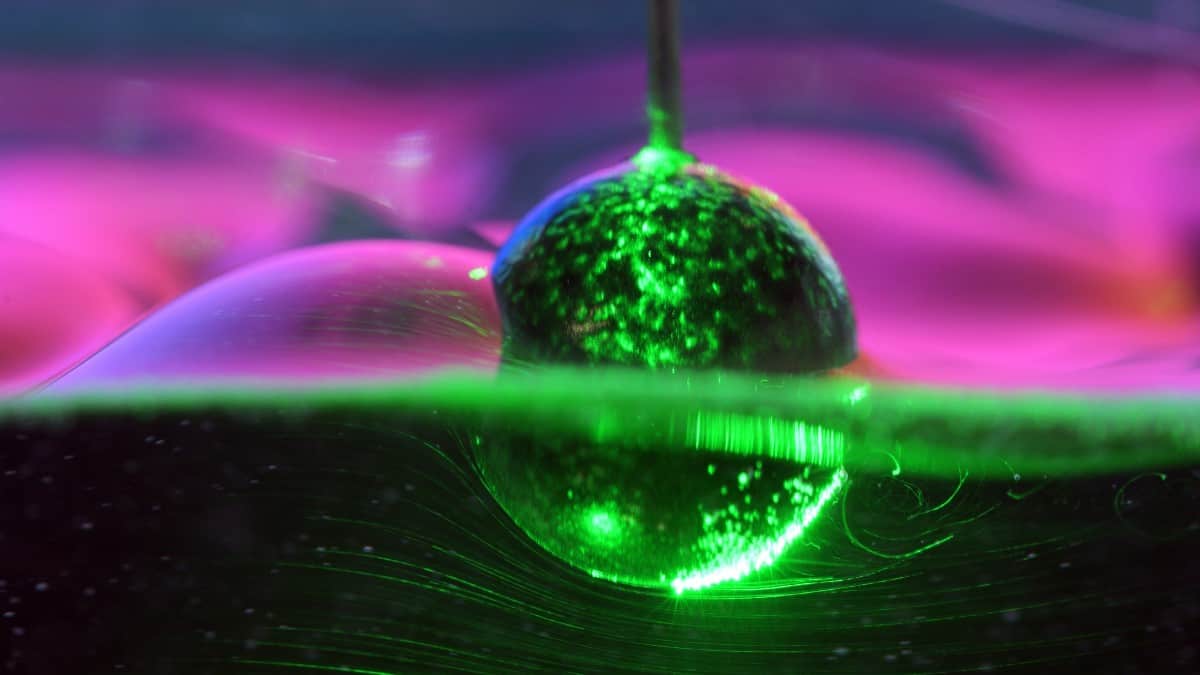
Researchers in the US have made several unexpected discoveries when observing how water flows around partially submerged spheres. Their simple experiments could lead to a better understanding of fluid flow in biological systems – and result in better designs of ships and aircraft.
Interactions between flowing fluids and solid objects play crucial roles in a wide range of phenomena from biological functions to the movement of goods and people around the world. These interactions are often studied by placing an object in an air or water flow and measuring the forces on it.
When an object is partially submerged in flowing water, it can experience greater drag than if that object is fully submerged. One reason for this is that at modest flow speeds greater than about 23 cm/s, a semi submerged object will create a wake of waves that dissipate energy – therefore increasing drag. As the flow speed increases, this results in the familiar wakes created by ships, which increase drag.
In a new study of how water flows past spheres, Robert Hunt and Daniel Harris at Brown University in the US and colleagues have discovered that semi submerged objects are subject to greater drag even at flow speeds of less than 23 cm/s. They also made the counterintuitive discovery that semi-submerged spheres with a water-repellent (hydrophobic) coating experience greater drag than spheres with water-attracting (hydrophilic) coatings. This came as a surprise because hydrophobic coatings are often used to decrease drag.
Deep dipping
The team did their experiments by dipping small spheres (8–13 mm diameter) into flowing water and measuring the drag. They found as the spheres dropped deeper into the water, the drag increased and did not start to fall until the spheres were fully submerged.
This increase is not unexpected because as a sphere goes deeper in the water it presents a greater surface area to the flow – and therefore the drag should increase. What surprised the team was that the drag on partially submerged objects was three or four times greater than that measured on a fully submerged object.
“You might naively approximate the drag by saying that if the sphere is almost 100% in the water, the drag is going to be almost the same as if it was fully immersed beneath the surface,” says Hunt. “What we found is the drag can actually can be much larger than that — and not like 50% but more like 300% or 400%.”
Low-speed drag
One surprising observation made by the team is that significant drag enhancement was observed for flow speeds below the minimum capillary-gravity wave speed of 23 cm/s. Below this speed, waves are not expected to be created around the object – and these waves tend to increase the drag. “This points to the possibility of other drag mechanisms that should be considered when operating at a free surface,” Harris told Physics World.
The team also looked how coating the surfaces of the spheres affected the drag. To do this they used spheres coated with three different materials. One coating was the superhydrophobic material NeverWet, which is very good at repelling water. Another coating was agar, which is a superhydrophilic material that attracts water. The third sphere was coated in an acrylic that has a middling affinity for water.
The team found that the superhydrophobic sphere experienced about 50% more drag just as the spheres were being fully submerged. Harris explains this using simple physics. “Essentially, the water that piles up in front of the object exerts an extra pressure on the front of the sphere and leads to an extra drag force,” explains Harris. This can be seen in the above figure, in which the flow is going left to right.

Is turbulent flow universal after all?
He adds, “A hydrophilic sphere more readily allows the water to flow over the top, minimizing the pile-up effect and letting the pressures in the front and the back become more equalized. A hydrophobic spheres more strongly resists the fluid flowing over the top, and thus maintains a larger pile-up for longer.” Harris says that this finding runs counter to some current thought on how to reduce drag. “Superhydrophobic coatings are often developed and proposed for drag reduction, and thus this finding was initially counter-intuitive,” observes Harris. “In trying to decrease the drag, you might actually increase it substantially.”
The team says that it is surprised that these simple measurements had not already been done before. Now, they hope to expand their research to study shapes that are relevant to biology and technology.
“Starting from the simplest point, we look at what are the physics here and then as a next step we begin to apply our knowledge to more realistic structures, whether it’s emulating a biological structure or looking at manmade propulsive structures,” Harris says. “We are interested in the design of small-scale autonomous robots that operate and propel at or near an air-water interface. Many of the existing designs of such devices are bioinspired, borrowing geometric or kinematic designs from nature, such as from the water strider or whirligig beetle.”
The research is described Physical Review Fluids.
